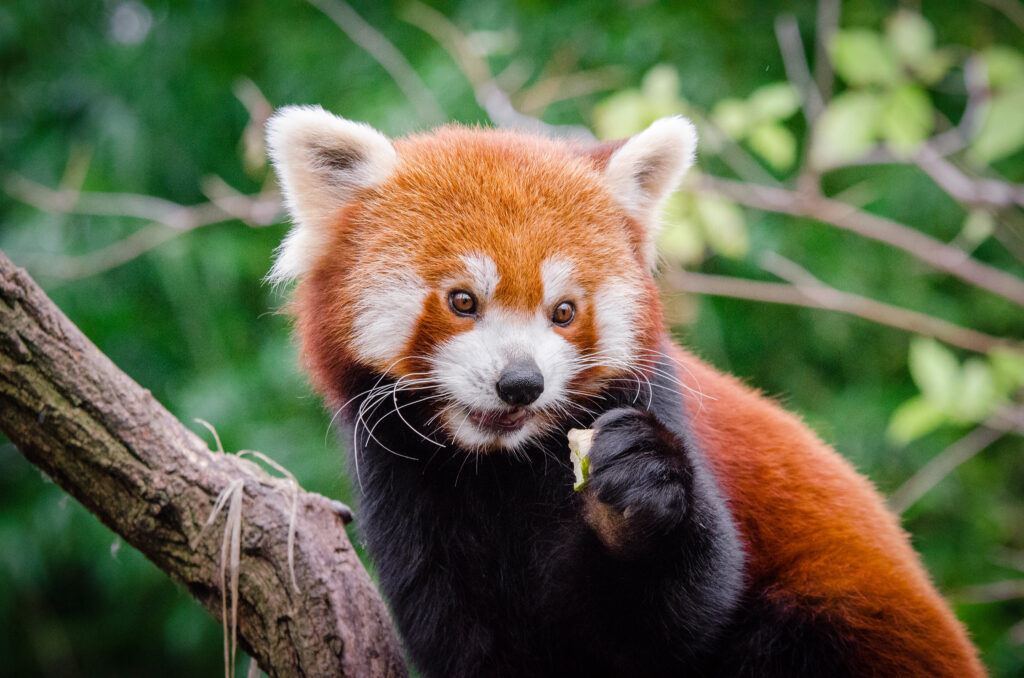
Red pandas are small mammals native to the mountainous forests of China, India, Nepal, Bhutan, and Myanmar. Unlike their name suggests, they are not related to giant pandas. In fact, red pandas are distant relatives of raccoons. Renowned for their tree-climbing abilities, red pandas live at moderately high elevations in the Himalayas where they forage widely for bamboo shoots and various fruits.
According to the International Union for the Conservation of Nature, red pandas are endangered. Scientists estimate that there are less than 10,000 red pandas remaining in the wild today, and these numbers are continuing to fall.
Habitat loss is the main threat to red panda’s survival. Human expansion into the area, combined with the effects of climate change, has led to the fragmentation and loss of livable land. Red pandas also face dangers from hunting and poaching.
According to new research recently published in the journal Landscape Ecology, human impacts are driving red pandas closer to extinction than previously thought. Using GPS telemetry, a research team from the University of Queensland in Australia tracked red pandas in Nepal over a 12-month period. The researchers found that human activities, such as infrastructure development, were causing red pandas to restrict their movements, which is further fragmenting their habitat and interfering with natural interactions between the animals.
As the amount of wild forest dwindles, red pandas are being forced into situations where they must decide whether to live closer to predators or adapt to co-exist with humans.
The research team recommends minimizing human-induced disturbances in red panda habitats and to maintain habitat continuity in ecologically sensitive areas.
**********
Web Links
Red pandas face a fractured future
Photo, posted November 27, 2016, courtesy of Mathias Appel via Flickr.
Earth Wise is a production of WAMC Northeast Public Radio.
Red Pandas are not endangered by climate change — thus your title itself is misinformation. Nothing is “combined with the effects of climate change” to change their situation.
The study “Effect of disturbances and habitat fragmentation on an arboreal habitat specialist mammal using GPS telemetry: a case of the red panda” in Landscape Ecology by Bista et al (2021) does not even contain the words “climate change”. Climate change is not listed anywhere in the paper as affecting the success or failure of this species. Climate is mentioned only to describe their habitat “a sub-tropical to temperate climate”.
According to the IUCN [ “https://www.iucnredlist.org/species/714/110023718#assessment-information ] it is not even certain that the populations are declining or at what rate — it is all surmised from growing human populations. The major factors affecting Red Pandas are: poaching (for meat, Chinese medicine, furs, and the pet industry) and habitat disruption as human incursion into their habitats increases. There is no mention of climate change in the assessments.
(Note that ALL IUCN pages have a obligatory section under Threats wherein they list possible future threats from a wide range of potential threats, including climate change — thus, if red panda habitat turned into a desert in some future climate scenario, it would threaten the pandas. There is no current threat and no current effect.)
Why you would include climate change is a mystery? Unless you are dedicated to spreading climate misinformation.
It’s interesting to see that the author, when caught in a direct lie, is unwilling to admit it and correct it.
“Have you no shame?”
https://wattsupwiththat.com/2022/07/06/how-climate-propaganda-works/